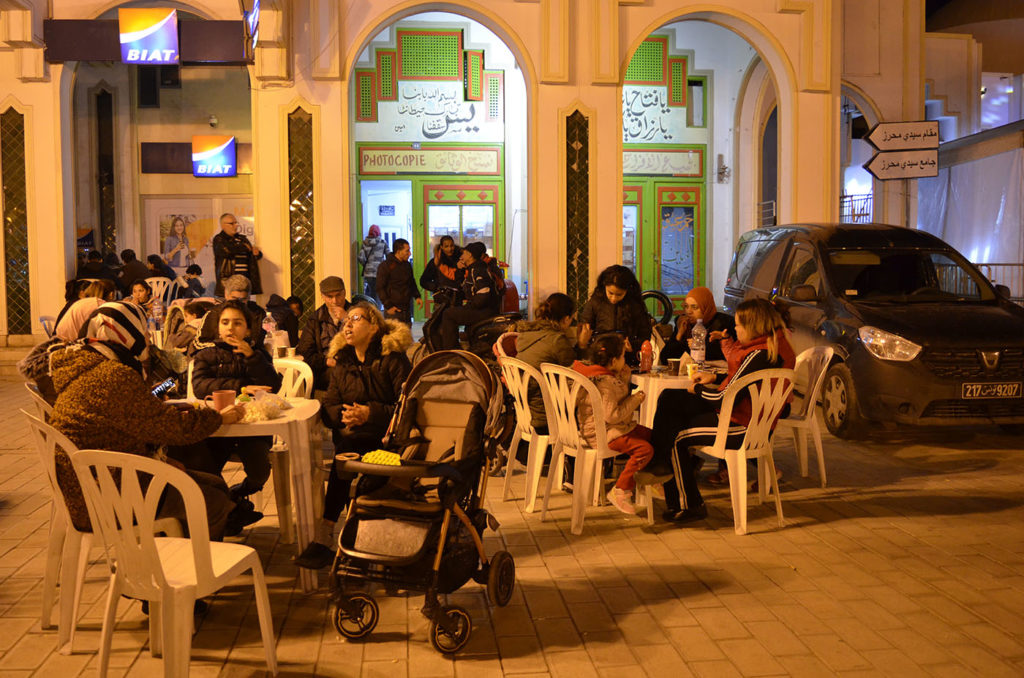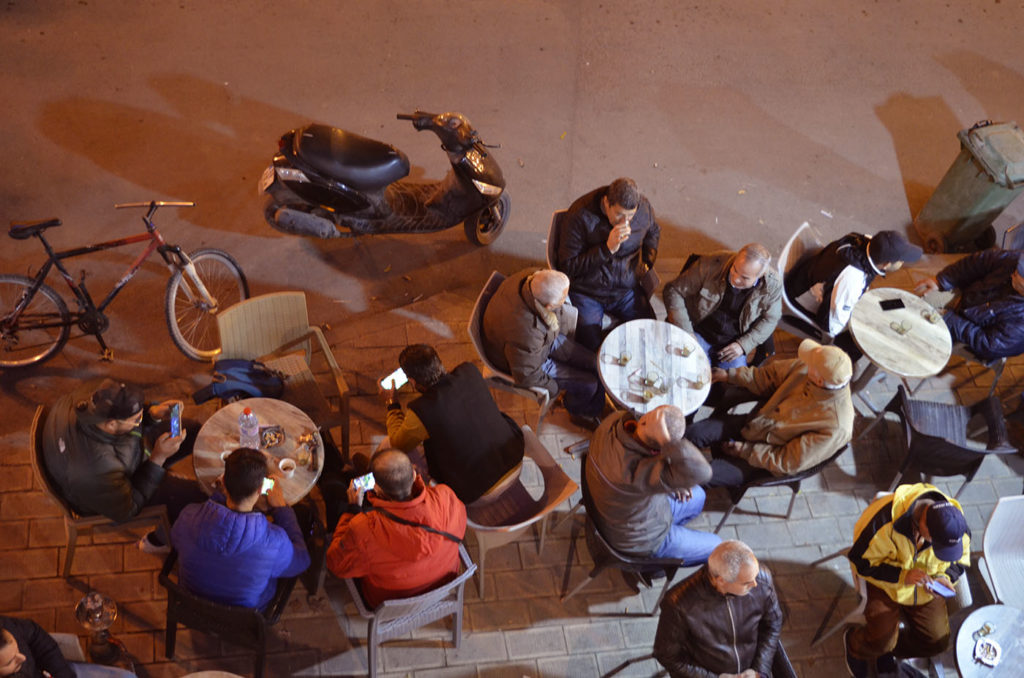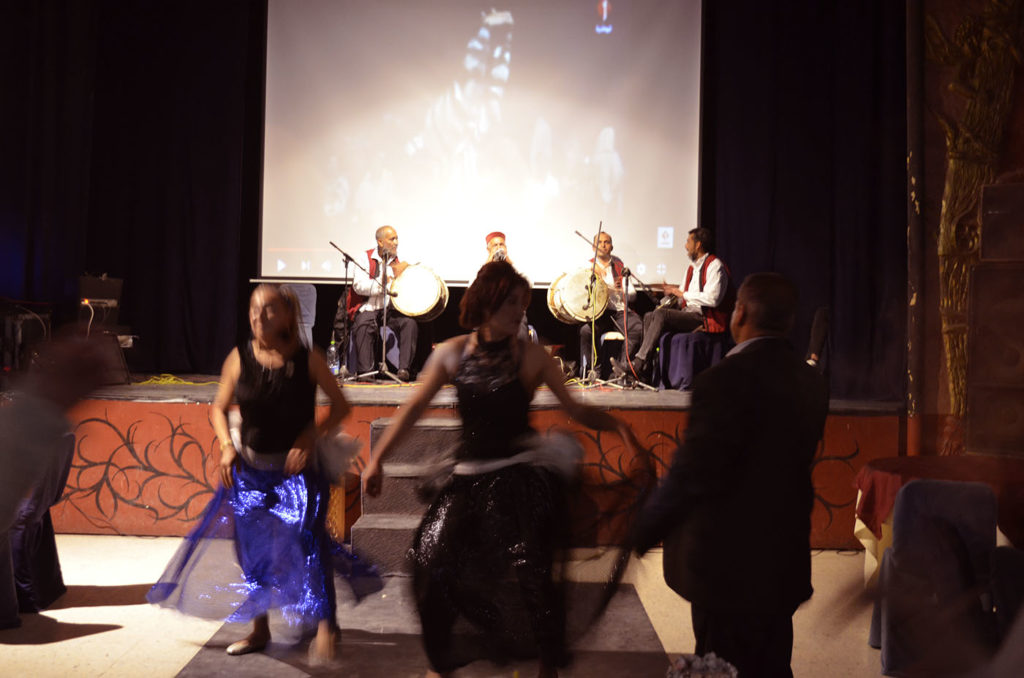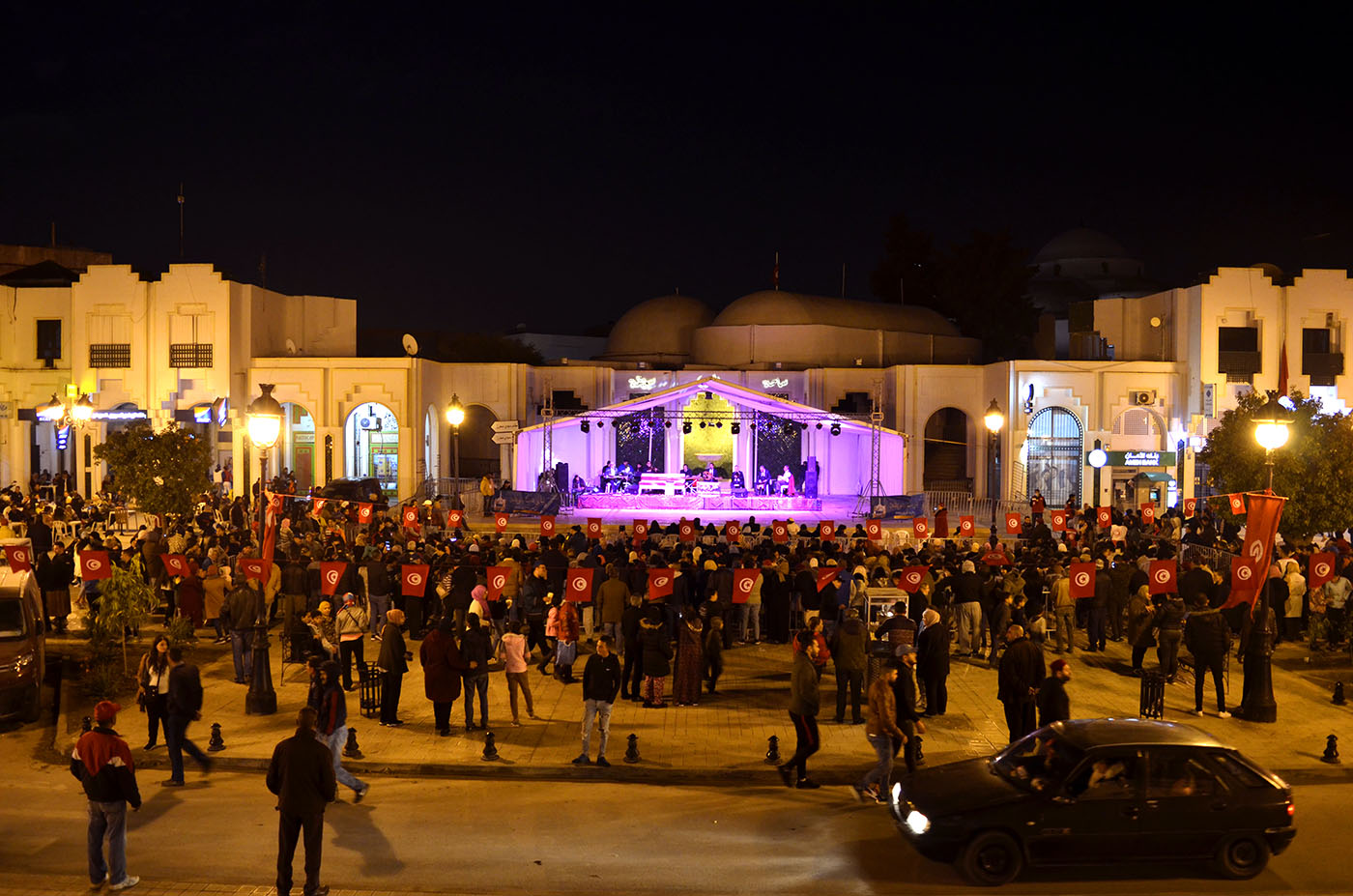Shreya Parikh
I walk out of my home, drawn towards an odd mixture of music and commotion that I hear while reading, hesitant about whether I want to be back walking in and through a public space. When I arrive at the source of these sounds on Place Bab Souika — a roundish public “square” which lies a parallel street away from home — the crowd is too thick for me to get a clear view of the performance that is at the center of everyone’s attention.
To get a better view, I decide to climb up the open flight of stairs that leads to the neighborhood cultural center which faces Place Bab Souika; the stairs give an elevated view onto the Place. I try to lean slowly onto the crowd, hoping to pressure them into moving, looking to find a railing to hold onto. The stairs are packed with peeking families looking onto Place Bab Souika where a temporary tent and stage hosts a music and dance performance. A man asks his daughter to make space for me, I smile back to thank him, and I move into the new spot that gives me a better view to the visual and musical spectacle. I stand there, hypnotized by the perfectly synchronized performance of mezoued by women dressed in identical white blouses and pastel striped skirts. They seem to be in a trance as well, their hair going back and forth up in the air.
It is past 10 in the night, later than my usual time for bed, but the festivity marking Ramadan only seems to be beginning. Accompanying the drums and the oud and the keyboard that produce the trance beats, I hear crunching sounds of popcorn being chewed by children standing around me, the barking of street dogs trying to make their way through the thickening crowd, the popping fireworks thrown around by little boys. “To get rid of the evil eye!” a passing human explains as I look perplexed by its unexpected sound.
I smell croissants and pains au chocolat coming from the old patisserie below me to my right. As I look down from the stairs, I see a chain of cafés below, hosting men smoking and staring at old football games being replayed on small televisions in these cafés. The café chairs and tables are set all over the pavement, and I watch as families try to wind their way through this maze and towards the stage, struggling. I start to dream of getting a directe (expresso mixed with foamed milk) and a croissant. Suddenly, my dream is interrupted by men on the stairs behind me who are whistling to the new musical tune being played on the stage on Place Bab Souika; the change in the music has marked a change in the dance style as well. So I try to concentrate again on the show; now I want to whistle along as well!
I don’t know how to whistle — is it because I am a woman that I never learnt how to whistle? I think of my women-ness and I realize that I am not the only woman in Bab Souika, in the public that crowds the square. I see young women in fleece pajamas and house slippers walking with their lovers, holding hands. I see women from across generations — grandmothers with their daughters-in-law and granddaughters — sitting in white plastic chairs in front of the makeshift theatre that has become Place Bab Souika; some are standing in front of their chairs, dancing slowly, snapping fingers gracefully in the air. I think of grace, its association with women, and my total lack of it!
Wasn’t grace a part of the unnamed education I received through my childhood? Then maybe I taught myself to not be graceful, so that I could somehow erase the woman-ness of my body as I moved in public spaces, so that I didn’t get seen as a “woman,” so that I could somehow avoid being harassed. But, here and now, I am jealous of these women and their grace — these women in perfect synchrony dancing on the stage with grace, women in the audience snapping fingers and swaying their shoulders. I want to dance too, with such grace!

Place Bab Souika marks the center of Bab Souika — a so-called populaire (working class) neighborhood on the edges of the medina in Tunis. Behind the Place lies the zaouia (mausoleum) of Sidi Mehrez, patron saint of the city of Tunis. Many of my colleagues grew up in middle and upper-middle class families in Bab Souika and now live in residential suburban areas of Tunis, like El Menzah, Bardo, or La Marsa; they talk about Bab Souika with nostalgia — a nostalgia that traces a cultural decline of the neighborhood. I wonder if this language for cultural decline hides a privileged class’s disgust for the “popular.”
Bab Souika became my home in the middle of the pandemic, while I separated myself from everything I had called family for the past decade, and perhaps from the past of my whole life. To make it home, I invented routines; every morning, I would walk around the souk in Halfaouine, zig-zagging through its meat and vegetable and second-hand clothing market, and chatting with the man who sells my favorite harissa, with the store owner who gifted me his personal lighter because the store was out of stock. I started to go to the same café in Place Bab Souika, developing a routine of friendly conversations with men who make and serve coffee there, who know exactly the order I take to an extent that there is barely a verbal exchange between us now; when they see me arrive, they ask “kima a’ada?” (same as usual?) and I nod my head. The men who make these everyday routines possible became a foundation of my own construction of home.
Outside of the time suspended by Ramadan, Place Bab Souika is a men’s space. Cafés that border the Place are what many call “café chaabi” or “café moustache” — cafés populaires catering to men from the neighborhood. I once asked the young man who serves coffee at the nameless café I go to everyday if there are cafes for women around; he pointed to a hidden space a few meters away and called it a salon de thé where families go. Since Ramadan has started, all the cafes disappear in the daytime until an hour before the call to prayer at sunset, when the daily fasting ends; women join men in many of these cafés. Outside of Ramadan, I have never seen a woman sit and order a coffee at the café I go to everyday; the only women figures are old women walking with giant bags of groceries, slowly making their way home from the nearby souk in Halfaouine, stopping at the café to sit on a chair and catch their breath.
I am aware during every second of my presence in Place Bab Souika, especially while sitting in the café drinking bitter coffee made the way I like, that my presence is tolerated but not fully accepted. Tolerated because I am a foreigner; not accepted because I am a woman. In a café I used to frequent last year, I was told by the server (with whom I had slowly gotten friendly and chatty) that I should not wear skirts in Bab Souika. Since that day, I stopped going to this café. It was a clear reminder that my presence created tension, generated gazes from men passing by.

Every time I pass by it, I still mourn the loss of the routine that consisted of that café. The incident raised many questions that I still have difficulties resolving — what should I do when the “local” norms clash with my desire to be comfortable in my very gendered body? Should I “respect” these norms because I am in a country where I am a foreigner? Does this mean that I stop wearing skirts, stop going to men’s cafés, stop walking through Place Bab Souika, and instead take the hidden alleys to commute — as I see countless women do?
The crowd behind me on the stairs is getting thicker so I decide that it is time to give in to my desire to get a croissant. I make my way down the stairs, winding my way through crowded café tables, a trampoline with jumping children, a half-empty merry-go-round with pink glitter ribbons threaded all over. I smell croissants! When I finally arrive at the patisserie, the line is too long and they are waiting for the baking stock of croissants and pains au chocolat to come out of the oven, for the ready stock is all gone. I decide to distract myself with the idea of checking out the other source of music next to the giant poster of “Cafi Chanta” that hangs above the walls of the nameless café of my preference.
I had heard of “Cafi Chanta” as a part of the mythical past of Bab Souika — cafes hosting famous local artists who sang through the night. Its appellation is a vernacularization of “Café Chantant,” which can be loosely translated as “singing café.” Given its location in the nostalgic past, I did not expect to find it in the present!
I walk towards the poster, looking for a way to get to the first floor from where I hear the music coming. The giant hand-painted poster depicts a woman dressed in a long tunic in various shades of light blue, holding a lantern in one hand and an oversized coffee cup in the other. I can barely see any expressions on her face. Finally, I find the stairs slightly hidden away behind a wall. As I climb the stairs, I see a sign with a hand-painted pale-skin woman dressed in red bra and red skirt — clothing associated with bellydancing — with a note that reads “100% jeunes,” indicating that the women in Cafi Chanta are “100%” young. The stairs smell of urine. The walls are stripped in yellow and red, the colors of Bab Souika’s famous men’s football team, Club Espérance. I feel like I am walking into a space where I do not belong.
I arrive on the first floor and spot the only open door and enter it. There are three men standing around the door whom I ignore because I am scared that if I look into their eyes, they won’t allow me to enter. I walk in and spot the kitchen area of the café to my left, where a young man is preparing tea. I continue, ignoring his presence, scared of being spotted and kicked out at any moment, and I finally find myself in a dark room that smells like hookah. There are round tables everywhere, covered in red cloth, and there is not a single table that is empty. I walk towards the source of music and find an empty chair on a table already occupied. I suppress my intuition that tells me that I am not supposed to be there, and I pretend that I don’t know the norms that govern where my classed and gendered body is supposed to go and not go. I bring out my camera from my bag and start to discreetly take pictures, ignoring any gaze at me and my foreign presence.

On the slightly mounted stage lit with round neon-colored lights, there are five men playing traditional drums and flutes. They all wear read chechia. A man dressed in a grey suit too loose on his frame is singing while walking through the audience. He has the turfs of his balding head gelled back; I notice that he is missing a few front teeth. Behind him, two women are dancing. They are both dressed in a black top, black leggings, and a translucent blue skirt that they wave as they move and swirl. I begin to have a constant desire to move in my chair, as if my body was itching, and probably a sign of my anxiousness; so I remind myself to perform my tourist-self – concentrate, smile, take pictures!
A family is seated at the table in front of me and I look at the mother in beige hijab and jellaba, red lipstick, black-rimmed glasses. She reminds of my classmates in high school back in India, the kind who are studious and would always do their homework. I imagine she probably did all her homework in school. Her two daughters are to her left, dressed in loose white ironed shirts; they are standing in front of their chairs, dancing and singing along. Her husband sits next to her on the right, smoking hookah with one hand, another hand on the shoulders of his son sitting to his right. His short hair is gelled and combed back. I can’t imagine my family ever going on a similar excursion together.
To their right is a table full of young women. These women all take turns in recording themselves on the phone, smiling, lip syncing, snapping their fingers and keeping the beat with their shoulders moving. The first woman I notice is the one wearing a pastel green hijab, singing along, capturing a selfie video with her friends. I reprimand myself for always noticing women who wear hijab. As I had walked up the stairs to arrive here, I had imagined a space of sexual excess catering to men; I am surprised by the presence of women here.
I look again at the table filled with women and realize that the twitching anxiousness I am experiencing may not be attributable to the fact that I am a woman in that space. I am so used to being the only woman in Bab Souika that my immediate reaction is to attribute my discomfort to the male-dominated nature of public spaces, including their cafes and restaurants.
I sit there and look at the two women who are dancing in the dark room with flashes of neon lights falling everywhere. I feel ill at ease and realize that, maybe this time, it might be a question of how I have been taught to live in and perform a certain social class that makes it impossible for me to inhabit that space in the way that the group of women on the table to my right are comfortably inhabiting theirs.
The microphone makes a screeching sound and I notice the rough echoes of the vocals, blaming it on a bad sound set-up. But for this yet another judgement I make about the place, I immediately reprimand myself. With my training in sociology, I am supposed to have learnt not to always be judging, to be able to reflect and go beyond the tastes I adopted to perform a social class, tastes I adopted to distinguish myself from a constructed other – the “public.”

During my childhood in India, I grew up detesting the public — public toilets, public fairs, public spaces, and the “public.” In the vernacular that we use in Ahmedabad, the public stands for people. But not everyone is people! “There is too much public there” is a common complaint we make to describe a crowded place of our dislike in my family. This includes weddings that we don’t want to attend, public gardens, and government-run buses. The public is a classed construction. Through our “developed” taste for things, I learnt to construct my ways of inhabiting space in a way that separated myself from this “public,” distinguishing myself from this “public.” In my family, we had the means to pay to be individuals separate from the public; I grew up taking rickshaws rather than public buses in Ahmedabad, buying up (even if temporarily) a private space for myself that I didn’t have to share with others. Every time my reflections considered the classed nature of my habit of taking rickshaws, I would justify it with my status as a woman and the vulnerability to sexual harassment that I faced; I fought my own self in naming the habit and the problem. I was always jealous of my classmates who were chauffeured around in cars as they went from school to private tutors to cinema. Maybe I was “public” for them!
The threat of sexual harassment is a real problem in Indian public spaces, as it is in Tunisia and elsewhere, and I don’t want to erase that; it is omnipresent and I can recount the multiple incidents of micro- and not-so-micro harassments that I have faced and that I continue to face the moment I put my feet out of my home. But that doesn’t fully explain my avoidance and my distaste for the public in my childhood. A destabilizing reflection on my embeddedness in social class needs to be brought in and taken seriously, and it was the beginning of the acceptance of this destabilizing reflection that I was experiencing as an anxious woman, twitching while sitting in Cafi Chanta.
Maybe my current curiosity in everything public still lies in the position of moral superiority that I (unconsciously) learnt as a part of my classed upbringing. This morality is constructed and performed every day to distinguish those in an economically privileged position from those not so privileged. I learnt to distinguish myself from the “public” using these constructed tastes and morality.
The song that the balding man is singing comes to an end and the dancers retreat to the backstage. A musician puts down his drum and heads out to the terrace to smoke. I am too bored and anxious to sit through this musical break and so I walk out of Cafi Chanta, hoping that my exit goes unnoticed. I make my way back through the crowded tables in front of the men’s cafés, spread across the pavement, and climb up the stairs to the cultural center again to stare at Place Bab Souika. Midway, I decide to put on the hood of my coat, hoping to hide away my foreignness, hoping to become, once and for all, the “public.” I want to feel the joy that those around me are feeling. It has to be joyous if those around are clapping and whistling to the music! I want to clap and whistle as well, forget about the messy entanglements of my own classed and gendered body, and drown myself in this joy of the public that is Place Bab Souika.




